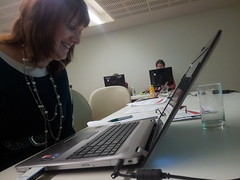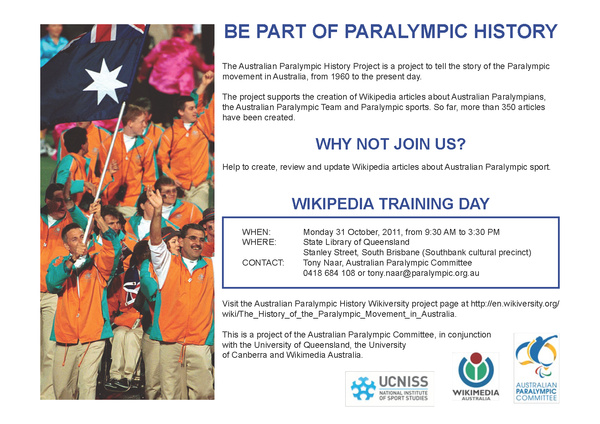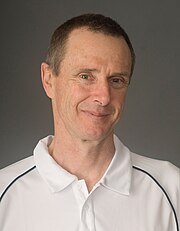What does it take to get an article to DYK? What does the process involve? What happens after an article appears on DYK? Why do we send Australian Paralympic articles to DYK?
The article is at the heart of it. First, an article has to be newly created in the past five days or expanded five-fold in the past five days. Second, the article must be 1,500 characters of prose long. Information in the article must be
verifiable, where people can verify by checking the source listed on Wikipedia. The article must also comply with other Wikipedia policies and guidelines like
Biographies of Living People, which is intended to make sure articles do not contain
original research, are
neutral and verifiable. It also needs to be free of copyright violations and plagiarism. That’s what an article needs before it can be nominated. How are articles selected for expansion with a goal of becoming DYKs? It depends. Two articles that became DYKs were started on or expanded by people not officially affiliated with the project. These were
Elizabeth Edmondson and
David Hall. We saw contributors working on these articles and decided to help and encourage the contributors to get the articles to a point where they could be taken to DYK. On our own, the choice to improve articles to get them to DYK happened for a variety of reasons: An article was
personally interesting to one of the
contributors, getting
sporadic edits by other contributors,
had pictures that could be
included on it, was on a
priority list of articles to be improved or was
near the top of the alphabet. There is no real systematic effort to get certain types of articles or a list of articles through DYK based on any set of criteria.
Once an article has been written and meets the bare criteria for DYK, the next step is to ask for help with the article. When I see an article close to being DYK ready, I like to come in and try to improve the article by fixing citations, improving prose, etc. When I am writing a DYK, I like to ask
Graham87,
Hawkeye7,
LeighBlackall and
John Vandenberg to do a copy edit, with an eye towards making the article ready for DYK submission. It is a useful and important step because it generally helps prevent against accusations of word padding to get to DYK, improves the clarity of the wording to make sure things are factual and match with the source, and generally improves the readability of the article. Beyond that, this step helps bring wider community engagement. People watch other people on Wikipedia and commenting on another person’s talk page means an article will likely get a few additional views and potential contributors as a result.
After an article has been copyedited, the next step is to take an article to DYK. In the case of Australian Paralympic DYKs, a few people have actually done the submission. Who does the submission is entirely up to the article writer, contributor or community. For one of our
DYKS, the DYK was submitted by the non-APC project involved contributor,
KansaiDan. For most of the rest, I asked
Hawkeye7 or
John Vandenberg to nominate the articles. This is because both of these users are very familiar with the DYK process and are capable of reviewing other DYKs because of their wider experience with content review. The familiarity with content review is important because the current DYK process requires anyone submitting a DYK must also review an article nominated for DYK. When they nominate an article, they need to
find a hook for the article. The hook should be some interesting piece of interesting information that will hook people into reading the article. Examples of hooks used in APC DYKs include:
|
|
- … that two-time US Open women’s wheelchair tennis champion Daniela Di Toro became paraplegic when a wall fell on her while she was competing at a school swimming carnival?”
|
|
|
- … that Alicia Aberley is a Paralympic swimmer who has held multiple world records and works for Amway?”
|
- … that wheelchair-tennis player David Hall was inducted into the Sport Australia Hall of Fame in 2010?”
|
|
In trying to think of hooks for Australian Paralympians, there is a bit of a personal struggle for me as a nominator/encouraging others to nominate. Paralympic medalists are fantastic competitors. They train more and can often do more athletically than I can as an able bodied person. Their performances speak for themselves. I want people to read articles about these athletes, not because they are disabled, but because they are fantastic athletes. The problem with developing hooks is the fact which would get the most readers may be seen as exploitative of the athlete’s disability. For me and others connected with the project, we try to make sure that when we nominate articles, most hooks we submit do not include a facts that could be read that way. Beyond the hook being interest, the nominator also checks to see if there is an image of the Paralympian. Articles with pictures often get more viewers. The submission needs to be properly formatted.
Once an article has been nominated, the article will be reviewed by one or more people. During this stage, the reviewer may edit the article to clarify wording or fix other minor problems. The reviewer may indicate there are some problems with the article and ask those to be fixed. For a few of the Australian Paralympic articles, people unaffiliated with the project as participants have come in to fix these problems on the article. In other cases, other editors have clarified issues where the reviewer may have concerns. This is often a second stage contribution and viewing burst associated with the article that can be seen by viewing article history and total article views. Once any and all issues have been addressed, the article is moved to the staging area and appears on the
main page of Wikipedia within a few days.
During the period when an article appears on the main page and for a day or so after the article appears, the article receives a large number of article views:
These numbers are substantially higher than the normal day to day page views for the article. Beyond the increase in views, the article often sees a third burst in article contributions. For example, editors will often fix grammatical errors not previously spotted in the article, remove trivial information, add new information, improve information boxes and add the article to additional categories. In most cases, Australian Paralympic articles appearing on the main page as DYK helps with efforts to continually
improve the article from a content, formatting and community perspective. That’s why we do send articles to DYK.







